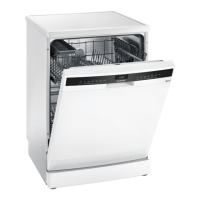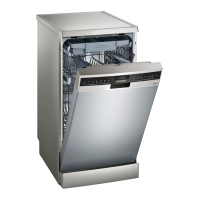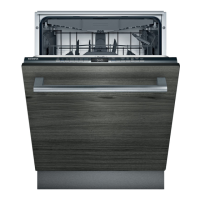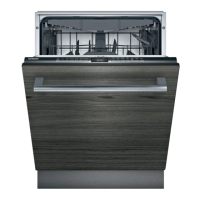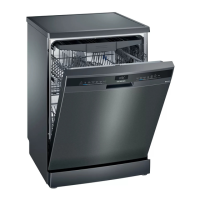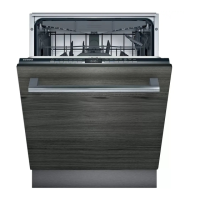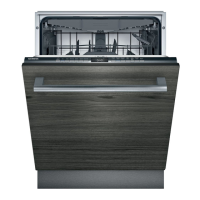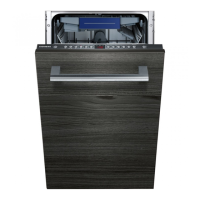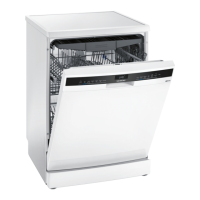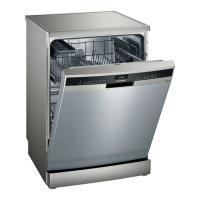Do you have a question about the Siemens iQ300 and is the answer not in the manual?
Read manual for safe and efficient use. Keep for future reference.
Only use for cleaning household tableware in private households up to 4000m altitude.
Children aged 8+ and persons with reduced abilities may use under supervision.
Follow safety instructions for proper appliance installation and connection.
Follow safety instructions for detergent/rinse aid and avoid hazards like explosion.
Do not operate a damaged appliance; follow safety instructions for repairs.
Protect children from suffocation, harm, crushing, and chemical burns from appliance parts.
Protect children from hazards, e.g., using the childproof lock.
Avoid damage from improper installation; follow guidelines for placement and water hoses.
Prevent damage from escaping vapour, special salt, detergent, or unsuitable cleaning agents.
Makes opening the appliance door more difficult; can be activated/deactivated in basic settings.
Recycle packaging materials by sorting components separately.
Use Eco 50° programme and Half Load function for reduced electricity and water consumption.
Check all parts after unpacking for damage and completeness.
Follow safety instructions and connect appliance correctly to power and water supply.
Connect appliance to drainage for dirty water discharge; check hose for kinks.
Connect appliance to a drinking water connection; ensure hose is not kinked.
Connect appliance to power supply; ensure plug is properly inserted.
Overview of the various parts of your dishwasher.
Controls configure functions and provide operating status information.
Explanation of buttons, display, and their functions for operating the appliance.
Contact for test institutes with E-Nr. and FD number for comparability tests.
Overview of additional functions that can be selected depending on appliance configuration.
Details on features like Half Load, HygienePlus, IntensiveZone, ExtraDry, Shine & Dry.
Overview of possible features and how to use them, depending on appliance model.
How to arrange cups and glasses in the top basket and adjust its height.
How to arrange pans and plates in the bottom basket.
How to arrange cutlery in the cutlery basket.
How to arrange cutlery in the cutlery drawer and reorganise it.
Using the etagere for small cups, glasses, or large cutlery items.
Using folding prongs to position tableware securely, e.g., plates.
Holder for small items like plastic parts.
Shelf for long, sharp objects and long cutlery.
Spray head for cleaning large items like trays, grilles, and plates.
How to remove the baking sheet spray head from the appliance.
Table detailing top and bottom basket heights for different appliance heights.
Steps for initial setup: add salt, rinse aid, switch on, set water softening.
Table showing water hardness values and corresponding setting values.
How to set the water hardness on the appliance using programme buttons.
Using special salt to soften water and prevent limescale.
Instructions for filling the special salt dispenser, warning about detergent.
When to switch off the water softening system and how to do it.
How the appliance regenerates the water softening system and its effect on consumption.
Table of consumption values during regeneration of the water softening system.
Using rinse aid for optimum drying results and avoiding marks.
How to fill the rinse aid dispenser and precautions.
How to adjust rinse aid dispensing for optimal results.
Information on suitable detergents like tabs, powder, and liquid detergents.
Detergents to avoid, like hand washing-up liquid or chlorine-containing ones.
Guidance on using detergents marked as organic/ecological and setting systems accordingly.
How to open the detergent dispenser and add tablets, powder, or liquid detergent.
Avoid damage by identifying unsuitable tableware and using appropriate detergents.
Correctly arranging tableware for optimal washing results and to prevent damage.
How to open the appliance door and switch the appliance on.
How to select programmes, set additional functions, and timer programming.
How to start the selected programme and when it ends.
How to interrupt and resume a running programme.
How to end a programme early by cancelling it.
How to switch off the appliance and turn off the water tap.
How to configure appliance settings like water hardness, rinse aid, and drying.
How to clean the appliance tub, including warnings about chlorine detergents.
How the appliance self-cleans its interior at regular intervals.
Use only suitable cleaning products for the appliance.
Tips to ensure proper function, like wiping seals and leaving the door ajar.
Programme for cleaning the dishwasher to prevent faults and odours.
How to run the Machine Care programme with specific products.
How to remove and clean the micro, fine, and coarse filters.
Detailed steps for cleaning the filter system and its components.
How to remove and clean the upper and lower spray arms to prevent blockages.
Safety warnings for repairs and potential hazards like electric shock.
Troubleshooting for specific error codes like E:12, E:14, E:15, E:16, E:18.
More error codes and troubleshooting for water supply issues like blocked hoses.
Troubleshooting for issues like tableware not drying or water collection.
More on drying issues, cutlery not dry, and condensation.
Troubleshooting for food remnants, blocked filters, and detergent dispenser issues.
Troubleshooting for water marks, coatings, white deposits, and detergent issues.
Troubleshooting for tea/lipstick marks, coloured coatings, and deposits.
Troubleshooting for discoloured plastic parts and irreversible clouding of glassware.
Explanations for display indicators like salt refill, rinse aid refill, and flashing displays.
Troubleshooting for water left in appliance, failure to switch on, programme start/stop issues.
Troubleshooting for issues like appliance door not closing or noises from spray arms.
How to clean the wastewater pump to remove food remnants and foreign bodies.
Steps to safely remove the appliance for transport or disposal.
How to empty the appliance completely to protect it from frost in cold environments.
How to properly prepare and transport the dishwasher to avoid damage.
How to dispose of the appliance in an environmentally friendly manner, with safety warnings.
Location of product and production numbers for customer service and warranty.
Details of the AQUA-STOP guarantee and its conditions.
Read manual for safe and efficient use. Keep for future reference.
Only use for cleaning household tableware in private households up to 4000m altitude.
Children aged 8+ and persons with reduced abilities may use under supervision.
Follow safety instructions for proper appliance installation and connection.
Follow safety instructions for detergent/rinse aid and avoid hazards like explosion.
Do not operate a damaged appliance; follow safety instructions for repairs.
Protect children from suffocation, harm, crushing, and chemical burns from appliance parts.
Protect children from hazards, e.g., using the childproof lock.
Avoid damage from improper installation; follow guidelines for placement and water hoses.
Prevent damage from escaping vapour, special salt, detergent, or unsuitable cleaning agents.
Makes opening the appliance door more difficult; can be activated/deactivated in basic settings.
Recycle packaging materials by sorting components separately.
Use Eco 50° programme and Half Load function for reduced electricity and water consumption.
Check all parts after unpacking for damage and completeness.
Follow safety instructions and connect appliance correctly to power and water supply.
Connect appliance to drainage for dirty water discharge; check hose for kinks.
Connect appliance to a drinking water connection; ensure hose is not kinked.
Connect appliance to power supply; ensure plug is properly inserted.
Overview of the various parts of your dishwasher.
Controls configure functions and provide operating status information.
Explanation of buttons, display, and their functions for operating the appliance.
Contact for test institutes with E-Nr. and FD number for comparability tests.
Overview of additional functions that can be selected depending on appliance configuration.
Details on features like Half Load, HygienePlus, IntensiveZone, ExtraDry, Shine & Dry.
Overview of possible features and how to use them, depending on appliance model.
How to arrange cups and glasses in the top basket and adjust its height.
How to arrange pans and plates in the bottom basket.
How to arrange cutlery in the cutlery basket.
How to arrange cutlery in the cutlery drawer and reorganise it.
Using the etagere for small cups, glasses, or large cutlery items.
Using folding prongs to position tableware securely, e.g., plates.
Holder for small items like plastic parts.
Shelf for long, sharp objects and long cutlery.
Spray head for cleaning large items like trays, grilles, and plates.
How to remove the baking sheet spray head from the appliance.
Table detailing top and bottom basket heights for different appliance heights.
Steps for initial setup: add salt, rinse aid, switch on, set water softening.
Table showing water hardness values and corresponding setting values.
How to set the water hardness on the appliance using programme buttons.
Using special salt to soften water and prevent limescale.
Instructions for filling the special salt dispenser, warning about detergent.
When to switch off the water softening system and how to do it.
How the appliance regenerates the water softening system and its effect on consumption.
Table of consumption values during regeneration of the water softening system.
Using rinse aid for optimum drying results and avoiding marks.
How to fill the rinse aid dispenser and precautions.
How to adjust rinse aid dispensing for optimal results.
Information on suitable detergents like tabs, powder, and liquid detergents.
Detergents to avoid, like hand washing-up liquid or chlorine-containing ones.
Guidance on using detergents marked as organic/ecological and setting systems accordingly.
How to open the detergent dispenser and add tablets, powder, or liquid detergent.
Avoid damage by identifying unsuitable tableware and using appropriate detergents.
Correctly arranging tableware for optimal washing results and to prevent damage.
How to open the appliance door and switch the appliance on.
How to select programmes, set additional functions, and timer programming.
How to start the selected programme and when it ends.
How to interrupt and resume a running programme.
How to end a programme early by cancelling it.
How to switch off the appliance and turn off the water tap.
How to configure appliance settings like water hardness, rinse aid, and drying.
How to clean the appliance tub, including warnings about chlorine detergents.
How the appliance self-cleans its interior at regular intervals.
Use only suitable cleaning products for the appliance.
Tips to ensure proper function, like wiping seals and leaving the door ajar.
Programme for cleaning the dishwasher to prevent faults and odours.
How to run the Machine Care programme with specific products.
How to remove and clean the micro, fine, and coarse filters.
Detailed steps for cleaning the filter system and its components.
How to remove and clean the upper and lower spray arms to prevent blockages.
Safety warnings for repairs and potential hazards like electric shock.
Troubleshooting for specific error codes like E:12, E:14, E:15, E:16, E:18.
More error codes and troubleshooting for water supply issues like blocked hoses.
Troubleshooting for issues like tableware not drying or water collection.
More on drying issues, cutlery not dry, and condensation.
Troubleshooting for food remnants, blocked filters, and detergent dispenser issues.
Troubleshooting for water marks, coatings, white deposits, and detergent issues.
Troubleshooting for tea/lipstick marks, coloured coatings, and deposits.
Troubleshooting for discoloured plastic parts and irreversible clouding of glassware.
Explanations for display indicators like salt refill, rinse aid refill, and flashing displays.
Troubleshooting for water left in appliance, failure to switch on, programme start/stop issues.
Troubleshooting for issues like appliance door not closing or noises from spray arms.
How to clean the wastewater pump to remove food remnants and foreign bodies.
Steps to safely remove the appliance for transport or disposal.
How to empty the appliance completely to protect it from frost in cold environments.
How to properly prepare and transport the dishwasher to avoid damage.
How to dispose of the appliance in an environmentally friendly manner, with safety warnings.
Location of product and production numbers for customer service and warranty.
Details of the AQUA-STOP guarantee and its conditions.
| Current | 10 A |
|---|---|
| Heat source | Electric |
| AC input voltage | 220 - 240 V |
| AC input frequency | 50 Hz |
| Energy consumption | 3.9 kWh |
| Door hinge | Right |
| Cord length | 1.45 m |
| Control type | Buttons, Rotary |
| Display type | LED |
| Loading type | Front-load |
| Drying system | Condensation |
| Product color | White |
| Built-in display | No |
| Appliance placement | Freestanding |
| Noise level | 66 dB |
| Drying class | - |
| Drum capacity | 7 kg |
| Package depth | 625 mm |
| Package width | 875 mm |
| Package weight | 39000 g |
| Depth | 598 mm |
|---|---|
| Width | 842 mm |
| Height | 675 mm |
| Weight | 38000 g |
